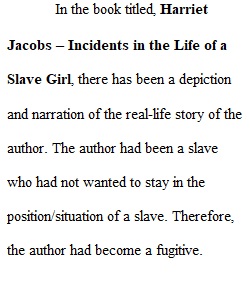


Q US History I Book Paper Assignment Students will write one 1000-1200 essay analyzing the historical context of a novel or autobiography that takes place in the US within the time frame covered in this class from early history to the end of the Civil War. You must not choose a history book. This is not a book review, and you must not simply summarize the book. Answer the assignment question. 1. The book must take place in the US up to 1865, not anything after. 2. The book must have been written before 1865 as well, not anything after. Paper question – What is the specific historical context which influenced the people and events portrayed in your book? Students must turn in the title of your chosen book for their paper by November 18 for instructor’s approval. All books must be approved by the professor. People who turn this in late or not at all will have points deducted from their final paper grade. The final word count must be at the end of the essay. Use Font size 12, times new roman, double spaced. This is an examination and analysis of the book, and the book only, so avoid using outside material or material from the lecture since this may cause you to try to prove things that are not in the book. Have an intro, a body, a conclusion. Have a thesis statement, and use the source and your analysis to prove your point, your thesis. The essay must be based on the book, and students must use quotes from the book to formulate and defend their argument, but don’t go overboard. Excessive or large quotes are not acceptable. Find only that part of the quote that gets to your point and use that. Be sure to explain to your reader how evidence from the book support your points. Use citations from the sources, such as (Douglass, p. 37). No cover page or bibliography is needed. Put your name on it. The paper is due by midnight December 2. Students must submit a copy on Canvas as a Microsoft Word attachment on the date due. Papers turned in incorrectly or after the due date will receive a substantial grading penalty. There will be no exceptions, unless approved by the instructor beforehand. Plagiarism will not be tolerated; plagiarized papers will receive a zero. Plagiarism is a direct violation of intellectual and academic honesty. Although it exists in many forms, all plagiarism refers to the same act: representing somebody else’s words or ideas as one’s own. The most extreme forms of plagiarism are those of material authored by another person or obtained from a commercial source, or the use of passages copied word for word without acknowledgement. Exact words from a source must be in quotes and cited, or it will be considered plagiarism. Paraphrasing an author’s idea or quoting even limited portions of his or her text without proper citation is also an act of plagiarism. Even putting someone else’s ideas into one’s own words without acknowledgement may be plagiarism. Explanations of just what plagiarism is and how to avoid it can be found at http://www.diigo.com/list/davidreeves/writing-tools Here are some examples or possible books you can choose from. These are not the only ones available, but can get you started. You can always ask a librarian, or go to the section of the library where novels from this period are located and just look through some and find one you like. If you have a book and you’re not sure if it fits the criteria, send me an email and ask. Examples of specific writer and novels, but there are others – Susan Warner – Wide, Wide World James Fennimore Cooper – Last of the Mohicans Nathaniel Hawthorne – Scarlet Letter Louisa May Alcott – Little Women Harriet Beacher Stowe – Uncle Tom’s Cabin Herman Melville – Moby Dick The Red Badge of Courage is not acceptable, as it was written after the Civil War. Example of autobiographies, but there are others – Autobiography of Frederick Douglass Harriet Jacobs – Incidents in the Life of a Slave Girl Henry David Thoreau – Walden There are very many slave narratives that are out there, as well as women’s diaries.
View Related Questions